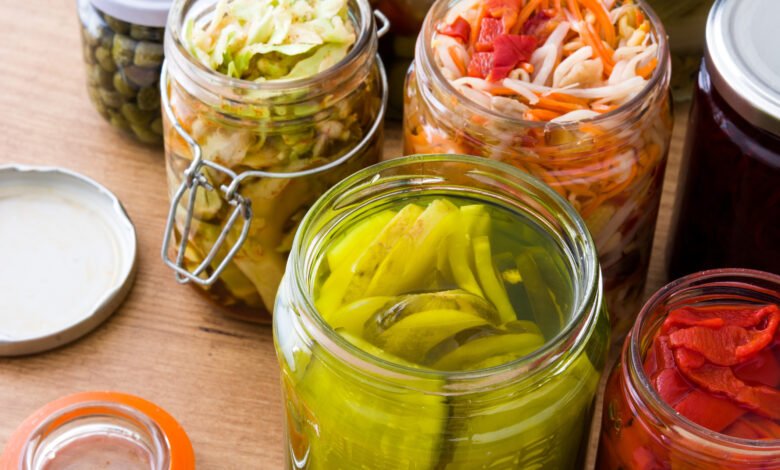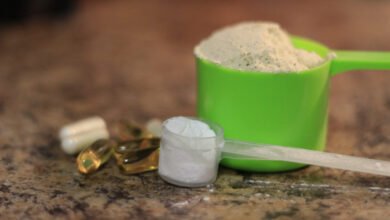What Are Fermented Foods? | Mark’s Daily Apple


Humans are designed to live harmoniously with bugs. I don’t mean mosquitoes and houseflies and bees—although those, too. I mean the microbes that live on and inside us, the ones that help us digest our food, maintain a proper pH, and produce important immune system components, hormones, and neurotransmitters.
Once, we humans would have encountered plenty of microbes on a daily basis because dirt and bacteria-ridden foods were a part of life. Not that this was always a good thing; food-borne illness was a danger to our ancestors just as it is now. Nevertheless, exposure to the unsanitized world meant people came in contact with, and ingested, microbes. To this day, the microbiomes in and on our body play a central role in healthy functioning.
That isn’t to suggest that you should be eating half-rotten food for your health. There are other, better options—like eating fermented foods.
You’re probably at least vaguely aware that fermented foods are good for you, though you might not know exactly why. They feature prominently in virtually all cuisines around the globe; not as much in the U.S. Today, I’m going to encourage you to include fermented foods in your diet if you aren’t already. I’ll also give you some of my favorites to start with.
Let’s dive in.
What Are Fermented Foods Anyway?
Fermentation occurs when microbes—often bacteria, sometimes fungi—on food begin to metabolize, or ferment, carbohydrates in the food. The end product of that metabolism is acid or alcohol. When done in a controlled environment like a vat of cabbage or a wine qvevri, the acid or alcohol builds up. Not only does this help preserve the food, it creates an inhospitable environment for dangerous pathogens that can make people sick.
Some form of fermented food is a standard component of just about every post-agricultural diet.
- The earliest sign of wine dates from about 8000 years ago in Georgia (Caucasus, not the state north of Florida). There’s evidence that people were fermenting drinks in Babylon circa 5000 BC, Egypt circa 3150 BC, Mexico circa 2000 BC, and Sudan circa 1500 BC.
- Fermented, leavened bread was produced in ancient Egypt, and milk was fermented in early Babylon as well.
- Roman soldiers often subsisted on long-fermented sourdough bread, which survived long treks well. (Imagine conquering the known world on a diet of bread—fermentation must be pretty effective stuff.)
- The Inuit traditionally wrap whole seabird carcasses in seal pelts and bury them underground to ferment for months, a dish called kiviak or kiviaq.
- Fermented dairy is a major aspect of the traditional Masai diet, as is clotted steer’s blood.
Don’t worry, I’m not suggesting you have to find a local purveyor of kiviak. There are plenty of ways to incorporate fermented foods that don’t require a seal carcass. But first…
Why Bother Including Fermented Foods in Your Diet?
You can understand why fermentation and other methods of food preservation were so important before the advent of refrigeration, but what about now? You might not appreciate the unique pungency of fermented dishes and condiments if you weren’t raised on the stuff, so is there any reason to make a point of eating fermented foods?
Decidedly yes. Foremost is that the microbes in the food, the ones doing the fermenting, act as probiotics. Consuming foods with living microbes is one of the controllable factors that add up to a healthy gut. The gut’s pivotal role in immunity, mental health, regulating inflammation, and of course digestion should be reason enough to add some sauerkraut to your eggs or down some full-fat yogurt after your workout. On the off chance you aren’t convinced, here’s some more food for thought:
- Fermentation can render previously inedible or potentially dangerous foods edible and somewhat nutritious. The lectins, gluten, and phytates in grains, for example, can be greatly reduced by fermentation. I don’t advocate the consumption of bread, but if you’re going to treat yourself to any gluten-y grain-derived food, make it real, long-fermented sourdough.
- The fermentation process breaks down the lactose in dairy, thus mitigating a potentially problematic sugar and decreasing the carb content.
- Before they’re turned into delicious, rich dark chocolate, cacao beans must first be fermented. This deepens the color and enriches the flavor, but most importantly it destroys the astringent tannins present in raw cacao.
Convinced? In that case, here’s where I’d start.
7 Fermented Foods for Primal Eaters
1. Yogurt
Yogurt has the lowest barrier to entry of all the fermented foods. I’m sure you’ve had yogurt on many occasions. If you’ve only eaten store-bought yogurt, though, you might not have gotten the good stuff.
Yogurt is made by adding cultures of bacterial strains, usually Streptococcus thermophilus and Lactobacillus bulgaricus, to milk and letting it ferment at warm temperatures for several hours. When you then eat the yogurt, you’re then consuming the live bacteria that have happily multiplied in the yogurt. At least, that’s what you want. Oftentimes, store-bought yogurt has been heated after production to kill any pathogens, but that also kills the live yogurt cultures. Then sugar and other ingredients are added to make it more palatable to the average consumer.
At the very least, look for yogurts that promise live cultures. If you really want to ensure the live probiotic benefits, make your own. It’s surprisingly simple, especially if you have an Instant Pot or slow cooker with a yogurt function. That also allows you to create bespoke yogurt recipes with the specific bacterial strains you want, like Dr. William Davis’s L. reuteri recipe.
2. Kefir
Kefir is similar to yogurt in that it’s a fermented dairy product, but with a couple key differences—the main one being the type of microbes used in the fermentation process. Kefir involves a symbiotic colony of bacteria and yeast, similar to the SCOBY used to make kombucha. The result is a drinkable beverage like thinned-out yogurt that has many times more probiotic strains than yogurt, including the namesake L. kefiri.
That doesn’t mean kefir is better than yogurt necessarily, just different. Studies have shown both can help calm the inflammation associated with IBD and put it in remission. Both have potential anti-cancer properties. Both can help eradicate H. pylori infection.
You get the picture. Rather than choosing between the two, I’d include both occasionally. Kefir is also incredibly easy to ferment at home, by the way. If you can let a jar of milk sit on your counter overnight, you can make kefir. Can’t do dairy? You can also make kefir from coconut water or plain water with some sugar added for the bacteria and yeast to ferment.
3. Fermented cabbage
This covers all your varieties of sauerkraut, kimchi, and countless other regional dishes made by fermenting the unassuming cruciferous vegetable.
Besides being a delicious hot dog topping, a small 2022 study found that consuming fermented vegetables, including sauerkraut, for just two weeks led to a favorable shift in the composition of the gut microbiome, with more desirable Bacteroides and a corresponding decrease in Prevotella species. Kimchi, a staple of Korean cuisine, is considered a health superfood, good for everything from the expected gut health benefits to anticancer properties and promoting cardiovascular health.
As with yogurt, if you want the probiotic benefits, you have to buy products that still have the live cultures. Start in the refrigerated section. Anything shelf-stable has been heated, so it will be inert. I’ve lately noticed kraut and kimchi purveyors popping up at local farmer’s markets, as well.
Or, once again, I’ll put in a plug for trying your hand at making sauerkraut. There’s a little art and a fair amount of science to it, but once you get the hang of it, the store-bought varieties will pale in comparison.
4. Natto
Natto, a Japanese form of fermented soybeans, is high in Vitamin K2 (MK-7), which is vital for bone, cardiovascular, and dental health. It’s definitely an acquired taste if it’s not something you grew up with, but it’s worth making the effort.
You might be surprised to hear me say that; most people assume I take a hard anti-soy line. Not so. (Natto so?) Soy doesn’t feature prominently in my diet, but I’m actually a fan of fermented soy products, and I don’t mind the whole beans. Everyone would do well to add some natto to their culinary oeuvre.
5. Apple cider vinegar
I’ve done a deep dive on the health benefits of ACV elsewhere. Most notably, dosing yourself with a couple tablespoons seems to have a rapid effect on blood sugar and insulin sensitivity. Experts think it’s the acetic acid in the vinegar that’s responsible for the observed benefits, not the microbes themselves. Since the microbes are the ones metabolizing sugars into acetic acid, though, let’s give them their due credit.
6. Kombucha
I’ve been a little hard on kombucha in the past, mostly because kombucha went through a period where it was, in my opinion, seriously overhyped as a health tonic. But that’s not kombucha’s fault. Perhaps I was being a tad harsh.
Kombucha does contain acetic acid, the same stuff that is supposed to make apple cider vinegar so good for you. The problem is, it also contains sugar—sometimes a fair amount. Kombucha is made by introducing bacteria and yeast into sugary tea and letting them do their fermentation thing. The longer it ferments, the more sugar will be metabolized, but also the more vinegary it becomes.
Usually, more sugar is added after fermentation to make it more appealing. That sugar is going to offset some of the blood sugar benefits surely, and there aren’t any good human studies pointing to other health benefits associated with drinking kombucha. But hey, if you like it, have at it. Look for low-sugar options, or (I sound like a broken record) make your own.
7. Beet kvass
For a lower-sugar fermented beverage option, what about kvass? Beet kvass, like sauerkraut, is a simple lactofermentation of vegetables in brine. The result is a salty, somewhat vinegary drink that, I won’t lie, isn’t going to be for everyone. I can’t find any research on beet kvass specifically, but it should yield similar benefits as other fermented vegetables.
Beet juice also has well-documented effects on blood flow to muscles and the brain, mitochondrial function, and muscle contractility, making it a useful supplement for athletes and, possibly, folks looking to enhance cognitive function.
Honorable Mention: Wine
Yes, wine is a fermented beverage, and yes, a fairly robust body of evidence suggests that some wine intake is good for you. I’d stop short of recommending that you pick up a wine habit if you’re not already a drinker, but I know I’ll get questions if I leave it off the list. For what it’s worth, the benefits of wine can mostly be chalked up to the polyphenol content, not any probiotic actions.
How to Add (More) Fermented Foods to Your Diet
The seven foods listed above are ones I’d consider entry-level fermentations (except beet kvass—you get extra credit for trying that one). They’re fairly easy to find and easy to add to Primal meals. The commercialized, store-bought versions generally won’t be as great as the ones Grandma used to make, but isn’t that always the case?
These just scratch the surface of what’s available, though. Once you start to delve into the wonderfully wide world of fermented foods, you’ll discover a virtually limitless array of fermented chutneys and relishes, sauces and condiments, vegetables and legumes, dairy products, and meats, eggs, and seafood.
Picky eaters can always pop probiotic supplements, but they’ll do nothing for gustatory pleasure. I encourage you to branch out if you’re willing. While many of the benefits of fermented foods overlap, each one will offer a little something different, much like the original foodstuffs from whence they come. If you’re someone who likes to travel, why not make it a point to seek out local fermented items? Your tastebuds will thank you. (Or maybe not, but you’ll have memorable meals in any case.)
Let me know: What’s your favorite fermented dish? Are you wild about saltwort? Crazy for curtido? Chime in in the comments.
If you’d like to add an avatar to all of your comments click here!





